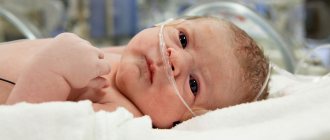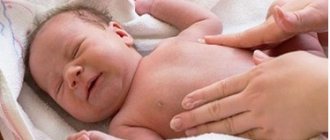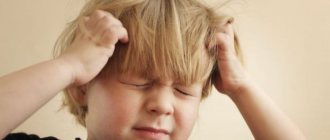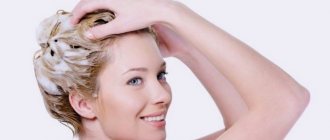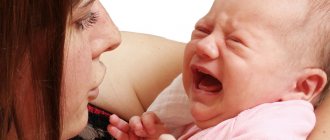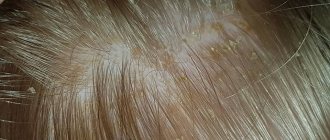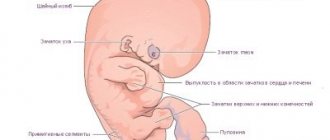The arrival of a baby in the family completely changes the lifestyle of young parents
. The baby takes up all their time and keeps them on their toes as they grow. Problems related to his behavior, nutrition, sleep and health often baffle even experienced parents, and even more so young ones. One of these troubling problems is the throwing back of the head and arching of the back in newborns.
Give a clear answer to the question: “ Why does an infant throw back his head and arch his back?
“It is impossible without an appropriate examination by a doctor, especially if there are accompanying signs of the disease such as constant crying, poor sleep and bowing of the legs. In these cases, it is clear that the baby is worried about pain, so you should definitely call a doctor home and undergo an examination. But if the baby throws his head back and arches his back only during feeding or sleeping for a long time in one position, then most likely he is full or has decided to stretch his spine.
If the baby is sleeping
, throwing his head back and arching his back, this means he likes this body position. He loves to learn new movements and wants to quickly learn about the world around him. For example, he became interested in some object or looked for his mother. However, you should definitely undergo an examination by a doctor if arching your back and throwing your head back has become a constant phenomenon in your child, even if he does not cry. Most often, the cause of this pathology in newborn babies is muscle hypertonicity.
panic _
, having heard from the lips of a doctor, the word “hypertonicity”, which is incomprehensible to many, is not needed. According to medical statistics, 90% of babies under the age of 6 months suffer from tone disorders. It’s just that in some children it is more pronounced, in others it is weaker. If a child has increased back tone, he often stands on a bridge. To check whether the cause of such acrobatic stunts is indeed muscle hypertonicity, you can test the child.
Testing procedure to detect increased muscle tension
can be performed from three months of age. To do this, place the baby on his stomach and carefully observe whether he tries to raise his head or not. If he throws his head back strongly, without even leaning on his hands, while his shoulders are raised, then this requires examination by a neurologist.
He will examine the baby
and will give you a referral for a relaxing massage, prescribe therapeutic exercises and rubbing your back with a special gel. Timely treatment under medical supervision will help completely correct the defect.
Usually children begin to turn from their back to their stomach
, starting from 4 months. In children with back hypertonicity, the opposite picture is observed. If you put them on their stomach, they immediately arch their back and turn their head in the direction on which side the problem is more pronounced. After this, the baby immediately falls on his back.
With muscle hypertonicity, a child
stops throwing his head back and turning over on his back after 10-15 massage sessions and physiotherapeutic procedures. But sometimes the cause of arching of the back and tilting of the head in young children can be a more serious reason - intracranial pressure, which requires examination by a doctor to rule out the presence of neurological diseases in the baby. Treatment of intracranial pressure is carried out under the supervision of a doctor.
To independently determine whether a child
intracranial pressure, take it under your armpits with your hands and try to stand it on its legs without releasing your hands. If the baby stands on his full foot, and not just on his toes, then the pressure in his head is normal. Intracranial pressure is dangerous due to complications and, if not treated in a timely manner, can lead to impaired cerebral circulation, the development of an abscess, meningitis, hydrocephalus and a brain tumor. Therefore, if, in addition to arching the back and throwing back the head, the baby does not sleep well, eats and often cries, then it is necessary to undergo an examination at the clinic to exclude the diagnosis of intracranial pressure.
Throwing back the head and arching the back in children
suffering from intestinal colic is a common occurrence. This is usually observed in children from 1 to 4 months and, as a rule, is accompanied by loud crying and bending of the legs. In this case, a warm compress on the tummy, massage, dill water and special medications that should be prescribed by a doctor will help relieve the problem.
In the absence of professional treatment
The consequences of throwing back the head and arching the back in babies can affect the development of the child. In adolescence, this can manifest itself as cervical osteochondrosis, causeless headaches, memory and attention disorders. Therefore, if, before the age of 6 months, you have concerns about your baby’s health due to any deviations in his behavior, it is better to immediately inform your local pediatrician about this and, if necessary, undergo an examination.
Video of children's massage techniques from the Institute of Massage
— You can find out about other massage techniques in the section “
Video of baby massage techniques"
— Return to the table of contents of the section “
Disease Prevention"
If arching occurs regularly, and there are no reasons described above, then increased back muscle tone is likely.
This is a fairly common reason, judging by the reports of parents who independently study through my online courses in early physical development.
The fact is that overstrained muscles do not allow the back to relax, hence the arching.
There are other possible reasons. I advise you to see a neurologist. His experience and knowledge will help you understand the situation.
Look at the photo where the child arches his back. Have you seen it in your baby? Read on to learn how to deal with this.
WHAT DEVELOPES A CHILD'S BRAIN BETTER THAN LEARNED LETTERS AND COLORS?
Movement is the main thing for a child under 3 years old. And I strive to give you the most useful and complete information about the development of children in a format convenient for you.
Therefore, I invite you to join my group on Facebook, where I tell you how to properly support the motor development of a child from 0️⃣ months to 1️⃣ year.
Expert posts and videos await you there: ✅ about child development; ✅ children's massage and gymnastics; ✅ about child care and health.
The group also hosts giveaways for my Baby Fitness courses!
Subscribe to the group on Facebook, send a message with the word “start” and receive FREE table describing all the important stages of baby development up to 1 year.
A child cries and arches his back: how to help?
Let's look at how to eliminate the reasons for the appearance of a bridge in a child:
- When arching after feeding, try massaging your belly before eating. The optimal number of massage repetitions is up to 5 times a day. Place your baby on his stomach more often. Roll your baby on his stomach on a fitball. All manipulations (massage, laying out and riding on a fitball) are done strictly before meals;
- If you have a runny nose , raise the mattress 30 degrees by placing something under it. This will improve the flow of mucus. Monitor the temperature and humidity in the room where the child is. Optimum temperature 21-22 degrees and humidity 40-60%
- When learning to roll onto your stomach, help your baby. Cross one leg over the other in the direction the baby wants to roll over. Wait for him to complete the rollover using his upper body;
- When crawling on your back, you need to teach your child the correct stereotype of crawling on all fours with the help of exercises. Moms successfully cope with learning all fours using my online course for early physical development 6-9 months;
Why does a newborn throw his head back and arch:
- for natural reasons (manifestation of emotions, peculiarities of muscle condition, colic);
- in case of health problems (congenital or acquired pathologies, infectious diseases).
The baby throws his head back and arches his back
To understand whether such behavior is normal for a child, carefully observe him. What details to pay attention to:
- How does a newborn feel in this position? Is he calm or capricious and crying?
- At what time is the baby in the position: during sleep or wakefulness.
- Is there visible muscle tension, trembling of the legs when he throws his head back. Is there any blueness around the lips and the area under the nose, what kind of look does the baby have (meaningful or not).
Newborn children throw their heads back for physiological, natural reasons, or this position provokes health problems.
When it's ok
In most cases this happens due to natural reasons. When throwing back the head and arching the back is considered normal:
- If parents do not react to the child’s manifestations of dissatisfaction, whimpering develops into crying and then into hysterics with arching of the body to attract attention. Be more attentive to your baby, monitor the emotional climate in the house. Surround your baby with care and love.
- Up to six months, newborns retain their natural increased muscle tone. If the doctor does not diagnose hypertonicity, then it will go away with age. Baby massage and bathing will help speed up muscle relaxation and eliminate head tilting and arching of the back.
- Attempts to roll over onto the tummy often begin with the newborn throwing his head back while lying on his side. He assesses the situation and prepares for a new skill.
- If there are interesting things or toys behind the child’s head, he tilts his head back to look at what interests him.
- Intestinal colic provokes discomfort and pain in the baby’s tummy; children press their legs to their stomach, nervously jerk them, cry, throw back their heads, burst into tears, and arch their backs. How to help your child: for mothers, watch their diet; for bottle-fed babies, choose a different formula. Do preventive exercises (bicycle), massage the tummy, bathe in a warm bath.
- If a newborn arches in his sleep, it is quite possible that this is a more comfortable position for him; there is nothing wrong with this if the child sleeps soundly and calmly.
When to be wary
There are a number of pathological reasons why babies throw their heads back and arch. You should be wary if a newborn in this position is too tense, he cries, you understand that he is uncomfortable or in pain.
What are the pathological causes of arching of the back in a newborn and tilting of the head:
- Stretching of nerve fibers due to irritation of the membranes of the brain. This is observed with increased intracranial pressure or with meningitis, hydrocephalus.
- Disorders of the brain, manifested in convulsive muscle contractions.
- Arching of the back occurs in diseases when neurons are affected and involuntary contractions occur (hypoxic-ischemic encephalopathy, cerebral palsy and the like).
- Congenital or acquired torticollis.
- Hypertonicity of the child's muscles.
Of the listed pathological causes of back arching, the most common are muscle hypertonicity and increased intracranial pressure.
Muscle hypertonicity
Hypertonicity differs from the natural increased muscle tone of a newborn. Hypertonicity is observed in children who have gone through fetal hypoxia, asphyxia or protracted, difficult labor. A doctor will help determine whether a child has a pathological condition or not. Parents should be wary if the baby not only throws back his head, but also constantly bends his arms and legs and does not relax them. Indicates a problem and movement disorder when the baby constantly uses only one hand when grasping a toy or an adult’s finger.
Increased intracranial pressure
The baby’s intracranial pressure increases due to other diseases or as a result of the pathological course of pregnancy or difficult childbirth. What symptoms indicate increased intracranial pressure in a newborn:
- bright light and noise are unpleasant to him, the reaction to such stimuli is emotional, sharply negative;
- the baby is restless, irritable;
- he cries for no reason, the crying is monotonous;
- regurgitation after eating several times at short intervals;
- he throws his head back, arches his back, there is a spasm of the muscles of the back and neck;
- the intervals between sleep are short;
- when screaming and crying, the tongue and lips tremble;
- blue discoloration of the nasolabial triangle;
- bulging of the large fontanel up to the divergence of the sutures, when the shape of the skull changes;
- convulsions;
- poor appetite;
- impaired eye movement, strabismus;
- the head grows too quickly relative to other parts of the body (compare according to the tables of the World Health Organization).
If you are concerned about your child’s condition, you understand that he is unwell, you observe the listed symptoms (all or several of them), consult a doctor immediately. The earlier treatment is started, the more effective it is.
Which specialist should I contact?
First of all, contact your local pediatrician. The doctor determines the severity of the baby's condition. If problems with the nervous system are suspected, the newborn will be referred for examination to a pediatric neurologist.
How parents can help the doctor make the correct diagnosis:
- remember how long ago you observed that the child throws his head back;
- whether the child had any illness before, whether he fell, or was afraid of something;
- when you observe such a pose - in a dream, during wakefulness;
- how the child behaves when he throws his head back - cries, screams, is there trembling in the body, blueness of the nasolabial triangle.
What diagnostics are prescribed?
The doctor examines the child, checks the condition of the skin, feels the tension in the back and neck muscles, and examines the extensor ability of the arms and legs. Asks clarifying questions to parents. If pregnancy and childbirth were difficult, it is important to tell your doctor. To prescribe competent treatment, one examination and survey is not always enough. Additional examinations are often required.
What additional diagnostics are prescribed:
- Electroencephalography - this procedure will help determine whether the newborn has epilepsy.
- General and detailed blood test, urine test.
- Neurosonography is an ultrasound examination of the child’s brain, it is carried out through an open large fontanel.
- CT or MRI are prescribed in extreme cases, because immobility is important for such a procedure. To take readings, you have to use anesthesia.
Prevention
If a newborn throws his head back and arches his back for physiological reasons, there is no cause for concern. What to do in this case to improve his health:
Parents should be wary if their child throws their head back in their sleep; in a dream, children can perform such an action due to pathologies. However, another reason is also possible: sometimes it is more convenient for the baby to rest this way; tilting back is a safe habit.
Safe reasons for this behavior
It is normal for a newborn baby to have his head tilted slightly forward. After birth, his body for some time retains the shape in which he was in his mother’s tummy - in the fetal position.
There are several aspects that can cause children to arch their head and back backward during sleep and when they are awake. According to doctors' observations, for the first three months after birth, children can sleep on their side and throw their head back, simply because it is most comfortable for them .
Another reason that the baby experiences discomfort is that mom and dad place the baby on its side. By bending his head, the baby chooses the most suitable position for him during sleep. After four months, the baby doesn't sleep like this very often.
Other possible and non-dangerous causes of a thrown back head include:
- getting to know the world . Little children grow up very quickly, and soon they become interested in everything that surrounds them.
When a baby hears a sound from behind, the reflex forces him to take a position that will give him the opportunity to see where the sound comes from.
In addition, if a child sometimes begins to be capricious if he cannot see what is happening behind him. In this case, you need to turn the baby's face in the direction that interests him so much and put him on his tummy.
- increased muscle tone in the area of the vertebrae of the neck. It is provoked by hysterical crying or other overexcitation.
In the first months of life, it is still very difficult for a baby to regulate his emotional mood, because the nervous system is still not stable until the age of one year.
During strong crying, which can be caused not only because of poor health, but also because of a feeling of hunger to take the baby in your arms, etc., the head can be thrown back, the back arched, and the arms and legs of the baby can shake very much.
You can reduce muscle tone; you just need to put the baby on his tummy and raise his head a little .
- external aspects . The baby reacts to extraneous sounds not only when he is awake. The moment he begins to fall asleep, other sounds in the room where he is may distract him. Older children may throw their head back when they roll over or have an emotional dream.
Is being capricious
Yes, very often the reason for all this is simply ordinary whims. The baby is tired of lying in one position or something doesn’t suit him. Maybe he wants to sleep or his tummy is bothering him. As a result, the child arches and begins to express his dissatisfaction. Or maybe the baby just wants to roll over to the other side, but his muscles are weak, so it doesn’t work out well.
During meals
He may begin to arch if he is already full or if he is not satisfied with your milk or someone distracted him and he was not too hungry. Breasts very often arch when they eat, so if this sometimes happens to you, then it’s okay.
Curiosity
Someone approached the baby from the back of the head. He hears it, but doesn't see it. Naturally, the child will begin to bend back to see who is walking behind him.
We recommend reading: Finger gymnastics for children from birth to 6 months
Very often, children, in order to look at some interesting toy or just something, begin to bend. That is, pure curiosity plays a role.
Colic in the stomach
I attributed this point to harmless reasons, since colic occurs in any child up to 4-5 months old and there is no escape from it. It's quite normal. If the baby's tummy bothers him greatly, he begins to twist in all directions and cry at the same time.
Why does a child throw his head back?
The reasons may vary. Some of them require consultation with a doctor, others do not pose a danger to children and do not require medical intervention.
If a baby throws his head back in his sleep, there is no need to worry: up to 4 months this is not a deviation or a developmental anomaly. You should be wary only in situations where other unpleasant symptoms are noted. Children under one year old adapt to changed conditions, adapt to the world around them; a newborn often throws his head back out of comfort.
The problem may arise due to birth injuries in which the neck or back was damaged in the upper part. Damage occurs especially often if the baby was born by caesarean section and special forceps were used to remove it.
Neurological pathologies are also possible. A child may arch in cases where he has increased muscle tone, intracranial pressure, or lacks oxygen.
Safe reasons may be observed. If one of the parents likes to sleep in a similar position, the child copies the position.
Sometimes a child sleeps with his head thrown back due to tantrums. If the child is not sleeping, he can take a similar position when trying to roll over: this is how the baby helps himself to make the movement.
In children under one year old
From the second month of life, the infant period begins, which will last up to 1 year. Babies up to 4 months retain physiological tone, so they “love” to sleep with their heads tilted back.
After six months it should no longer be there. The flexor and extensor muscles begin to work equally, which makes it possible to properly develop motor skills. The child begins to explore the world and express emotions. If he sees toys lying above, he will try to examine them by throwing back his head. After 4 months, mastering the turn from back to tummy begins with this movement. Capricious babies can throw a tantrum with arching their backs, throwing their heads back if they are unhappy with something. Turn the baby over onto his tummy and he will immediately straighten up.
In what cases should you look for pathology:
1. Damage to the nervous system and consequences of AEDs
After the first month of a child’s life, the consequences of PEP are monitored by a neurologist for up to a year. This is a recovery period. After a year, the diagnosis is removed (if everything is fine) or a different one is made - the one in which this same defeat will result. In addition, the infant’s nervous system remains vulnerable to the same damaging factors. The child may be injured or suffer a neuroinfection. Throwing back the head with stiffness of the neck muscles is a typical symptom of meningeal syndrome (develops with inflammation of the dura mater). The baby lies on its side in a “cocked” position: the head is thrown back, the legs are tucked towards the stomach. High temperature is combined with vomiting and severe headache (signaled by a “brain” cry).
2. Intestinal colic and teething
In babies 1-4 months old, colic is a very common occurrence. The child arches, throws his head back, cries loudly, and bends his legs. His tummy is swollen, and gases do not pass or are difficult to pass. This is how the baby reacts to acute pain. The condition goes away as soon as the colic is eliminated. Help the baby, lay him on his tummy, give him dill water or a colic drug recommended by the pediatrician. Teething is also accompanied by pain. At its peak, the baby cries, arches, pulls a pen or any foreign objects into his mouth. You can examine the oral cavity and see swollen gums or teething. Arching or throwing back can accompany any pain or stress in a baby. This is how the process of excitation of the nervous system manifests itself, and more developed muscles become toned. This in itself is not a pathology.
3. Premature babies, when hypertension does not appear immediately
They have their own characteristics. They are born in a state of reduced muscle tone, which gradually increases to normal, and then moderately increased. In very premature infants, such an increase in normal tone will appear only by the second month of life. If parents see that the child has suddenly begun to sleep with his head thrown back, they may be afraid. The reason may be that the tone is simply late. If necessary, the doctor will make a differential diagnosis with pathological hypertonicity.
You can distinguish pathological increased tone from natural in a baby by the following signs:
- Physiological tone goes away after 6 months, pathological tone not only remains, but can progress;
- A child with hypertonicity is very tense and tense. If normally a bent arm or leg can be easily separated, then you need to apply force;
- Hypertonicity persists during sleep, often accompanied by causeless crying and chin tremor;
The danger of increased tone is the delay in the baby’s motor development. The baby will not sit up/crawl/walk in due time. Fine motor skills will also suffer at an older age.
Whims or hypertonicity - how to determine
To understand why a baby throws his head back during sleep, you need to pay attention to the accompanying symptoms.
Hypertonicity is manifested by frequent regurgitation and decreased appetite. The baby often cries, worries, gets irritated, and rarely smiles. Healthy children sleep not only on their backs: the baby can fall asleep on his side or on his tummy; tilting back is infrequent and does not last too long. Possible blueness of the nasolabial triangle when tilted back, trembling in the chin.
You can also check for hypertension using special procedures. The child should be placed on his back. Then slowly, carefully raise your head so that your chin points towards your chest. With hypertonicity, the adult will feel resistance from the baby. There is another method. The baby is placed on his stomach. In this case, increased tone is manifested by raised shoulders, the baby throws his head back strongly. It is often accompanied by torticollis, so you should pay attention to which direction the head deviates.
If you do not get rid of the increased tone in a timely manner, a lag in physical and mental development is added. Children with disabilities later learn to crawl, talk, sit up, and walk.
Prevention of infant head tilt and hypertonicity
It is important to avoid lack of sleep and excessive fatigue. You need to put your baby down when signs of fatigue appear. To find out whether the baby sleeps enough time, you can use special tables with norms for babies of different ages. It is necessary to feed the baby in a timely manner, change his diapers in order to reduce anxiety and not create excessive stress.
If your child throws his head back in his sleep, you need to check the conditions in which he sleeps. Children under one year old do not need a pillow. There should be no foreign objects in the bed, including toys. Before putting the baby to bed, the room should be ventilated.
A favorable psychological environment will also help prevent tilting. If the mother is calm and balanced, the child will also be less irritable. Children at an early age understand well the emotions of others and are sensitive to them. It is important to control intonation with the baby: do not shout or sort things out. You can also use your voice to calm, speak quietly, gently: this will help the baby relax.
A woman should take precautions during pregnancy. It is important to lead a healthy lifestyle, follow your doctor’s recommendations, and walk a lot in the fresh air. It is better to prepare in advance for pregnancy and childbirth to reduce the risk of developing various abnormalities.
Muscle hypertonicity
Another common reason for arching your back when lying down is maximum muscle tension. When the baby turns three months old, you can determine at home whether he has muscle hypertonicity. To do this, just put the baby on his stomach and watch him raise his head. If he throws it back, arches his back, then the muscles are overstrained.
There are several other symptoms of overly tense muscles:
- the baby sleeps little and poorly;
- arches as if trying to stand on a bridge;
- when she cries, she throws her head back;
- it is difficult to separate your arms or legs - they are tense;
- reacts poorly to light or loud sound.
If muscle hypertonicity does not go away after three months, you should consult a doctor. When the situation is not critical, a back and neck massage that any mother can do will be useful. Gently massage the tense muscles of the baby's back and neck while lying down, gently stroke them, and the tension will subside and the baby's mood will improve.
Unfortunately, this is an unsafe complication. If you do not pay due attention to pronounced muscle hypertonicity, there may be unpleasant consequences:
- speech defects (burr, lisp);
- motor impairment;
- the child’s gait becomes irregular, he has a clubfoot;
- stooping is formed.
Adult Actions
It is necessary to contact a neurologist. The doctor should be informed about all observed symptoms, their severity, and frequency.
A special massage will help. It is not recommended to prescribe treatment measures or massage on your own: even a slight violation of technology can harm the baby. It's better to consult a specialist. Parents can massage their child’s fingers at home: this action is safe and can alleviate symptoms.
If your baby throws his head back in his sleep, you can try infant swimming. Before doing this, you should consult your doctor. Swimming will help relax your muscles and reduce tone. At home, it is recommended to add medicinal herbs to the water. Plants that have a calming effect should be used: chamomile, motherwort.
You can perform special gymnastics. The set of exercises should be prepared by a doctor. This measure helps improve coordination. General and local blood circulation becomes better, joints are developed. The child's appetite improves. Falling asleep is easier, sleep is better quality.
The baby arches and throws his head back in his sleep: reasons, isn’t this harmful?
The child throws his head back - this action alarms the parents. Indeed, this cannot be ignored. But there is no need to panic. The doctor will answer the main question of whether there is pathology. Before you get there, take a closer look at the child and get ready to answer these questions:
Head tilt may appear from the first days of life or later. As a symptom of the disease, it has no specific diagnostic value and is combined with other symptoms. This movement is directly associated with contraction or increased tone of an entire group of muscles (occipital, neck, back). Pathological tone differs from the usual tilt of the head back, as a motor act. The causes and manifestations have their own characteristics depending on age.
The child throws his head back: the opinion of Dr. Komarovsky
In Komarovsky’s opinion, if the baby sleeps with his head thrown back, you should not take any measures until the age of three months, since all children throw their heads back during this period. In addition, you can easily cause harm when interfering. The only safe way is baths with medicinal herbs, which should be done daily before bedtime. Add decoctions of string and chamomile to the bathing water.
When is it necessary to consult a neurologist?
A doctor's help will be required if the birth was difficult, since there is a high probability of injury, which may cause abnormalities to develop. The sooner the child is shown to the doctor, the sooner the diagnosis will be made and treatment prescribed; there will be fewer consequences, complications will not be as dangerous as if there is a delay. It is especially important to show the child to the doctor in a timely manner if, after childbirth, hematomas remain on the head, or if developmental disorders of the central nervous system organs are diagnosed.
It is necessary to show the baby to a specialist if there are signs of hypertonicity. If the child arches while lying on his side, there is decreased interest in food, low activity and frequent regurgitation, one limb moves worse than the other, it is also important to start treatment on time. In addition, a situation when a baby shakes its head from side to side in its sleep, or when the position of the head changes, a crying baby’s arms and legs begin to shake, is considered an alarming symptom.
You can consult a doctor for prevention if parents are not sure about the nature of the observed phenomenon. The doctor will tell you whether there is a pathology. If the doctor does not find any dangerous abnormalities, but the parents are still worried, you can visit another specialist and get a second opinion. This will help avoid medical errors and incompetence.
When a child's head tilt indicates intracranial pressure (ICP)
Typically, intracranial pressure is the result of a problematic pregnancy or injuries sustained during childbirth. It is known that if a pregnant woman experiences some complications in the later stages, they have little effect on the child’s health in the future. But it happens that some of them are subsequently detected by intracranial pressure.
At an older age, after 4 months, throwing back the head can be caused by muscular dystonia (muscles pulling the head) or increased intracranial pressure.
If there are phenomena of muscular dystonia, then a massage is necessary; if there is a suspicion of increased intracranial pressure, then it is necessary to conduct an ultrasound of the head (neurosonography) and, if the diagnosis is confirmed, to treat.
Causes of ICP
The main reason is any complications during pregnancy and childbirth. More often:
- lack of oxygen in the womb;
- umbilical cord entanglement;
- unnatural birth.
Everyone has intracranial pressure, both adults and children. This is fine. A deviation is considered when it is increased or decreased. Medical specialists note the manifestation of ICP in almost every newborn, but this does not mean that your baby has a death sentence.
For example, Dr. E.O. Komarovsky claims that such a diagnosis is given to almost every second baby , but in reality it is quite rare and very difficult to determine.
There is no need to panic, much less prescribe your child any medications or vitamins on your own. To understand whether there are reasons for concern, you need to observe the baby.
Symptoms of ICP
- poor baby sleep, frequent whims (sometimes on the contrary, lethargy); If ICP is not treated, the child faces mental impairment, blindness, and paralysis.
- frequent throwing back of the head, accompanied by trembling of the lower jaw, blueness of the skin between the child’s nose and lips;
- changes in the eye area: squint, the baby bulges his eyes, rolls them up, etc.;
- muscle tone;
- rapid growth of the head, its asymmetry;
- convulsions.
If most of the symptoms are detected, you should consult a doctor - a local pediatrician or neurologist. The specialist will conduct an examination, prescribe the necessary tests, medications, and procedures.


